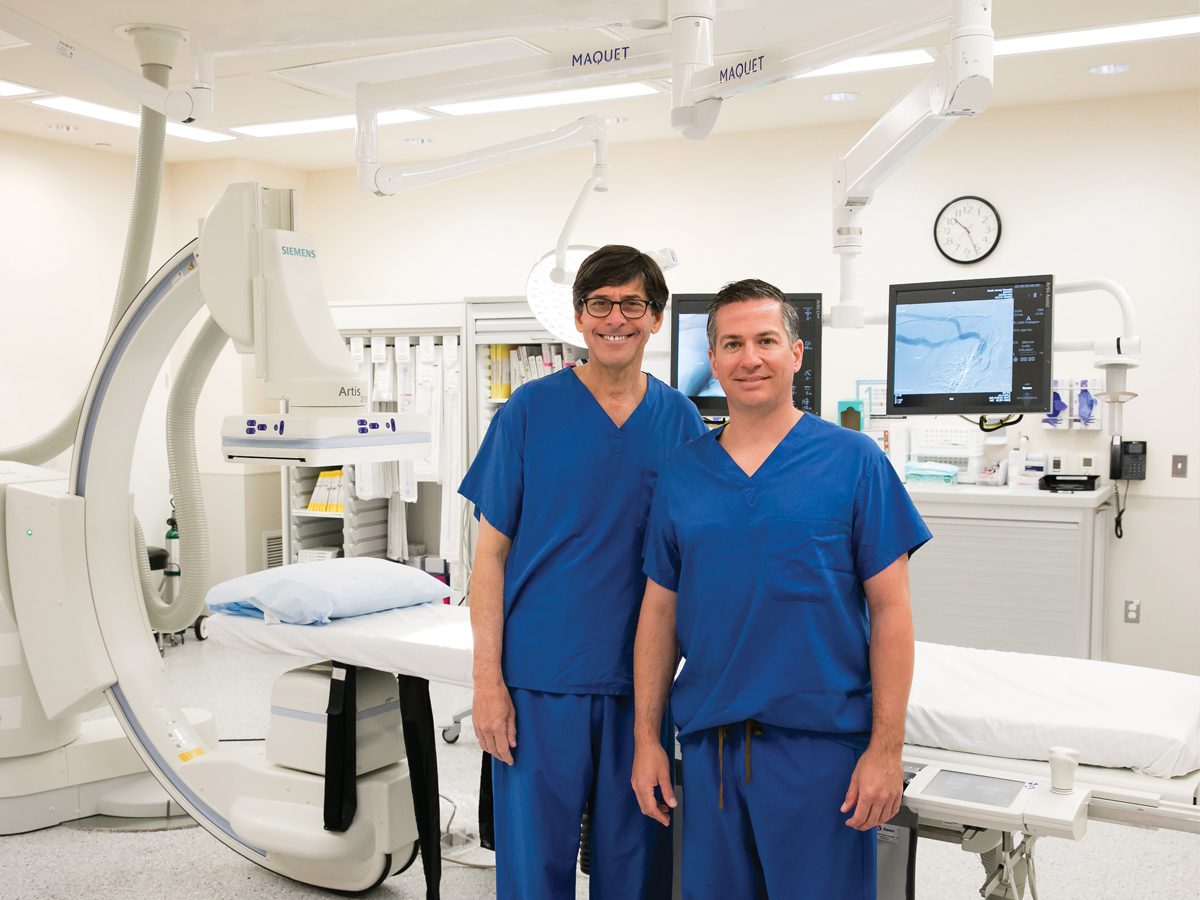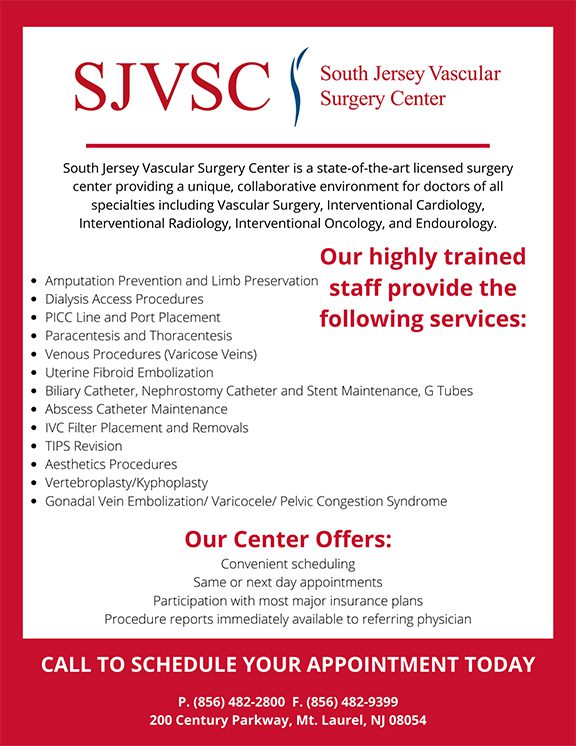Providing Patients with Exceptional Vascular Care

Drs. Paul J. Svigals, MD (left) and Brian A. Bianco, DO, MBA, DABR, inside a state-of-the-art operating suite at South Jersey Vascular Surgery Center
When facing a troubling medical issue that requires vascular care, the ability to have your procedure scheduled quickly with highly skilled physicians in a state-of-the-art facility is key.
As a fully-licensed outpatient, standalone ambulatory vascular care center conveniently located in Mt. Laurel, South Jersey Vascular Surgery Center (SJVSC) offers patients a full range of same-day interventional radiology and endovascular procedures for the treatment of vascular issues.
SJVSC is led by interventional radiologists Brian A. Bianco, DO, MBA, DABR, and Paul J. Svigals, MD, both fellowship-trained and board certified by the American Board of Radiology. Together, Bianco and Svigals handle over 2,500 procedures a year, largely centered on procedures such as angiograms for limb preservation, uterine fibroid embolization, port and PICC line placement and dialysis access maintenance.
“We’re an efficient, well-oiled practice,” Bianco says of the team that includes experienced nurses and technologists. “I’m really proud of the way over the last couple years we were able to take the pressure off hospitals so they could continue taking great care of Covid patients. For a segment of our patients, the care couldn’t wait.”

Limb loss prevention
One major focus for the physicians at SJVSC is the treatment of peripheral artery disease (PAD), in which plaque made up of cholesterol, calcium and fat causes blockages in the arteries of the legs. In its most mild form, patients with PAD have claudication – pain in the legs when they walk or exercise. While lifestyle modifications can help treat the disease in its earliest forms, says Bianco, for a substantial percentage of patients with PAD, their disease progresses over time to something called critical limb ischemia.
“That’s where our expertise comes in,” says Bianco. “When you have critical limb ischemia, your chance of limb loss or amputation goes up significantly.”
Bianco and Svigals are committed to helping patients avoid limb loss by utilizing minimally invasive techniques like peripheral angioplasty, stenting and atherectomy procedures. During these procedures, the physicians create a small nick over the hip or through the foot and insert angioplasty balloons, stents or other atherectomy devices to restore blood flow to the legs and feet. Avoiding amputation is paramount, says Bianco, as “the morbidity and mortality associated with limb loss is significant.”
Restoring quality of life
Another medical issue frequently seen at SJVSC are uterine fibroids, which are benign masses in the uterus that can severely impact a woman’s quality of life. Uterine fibroids cause heavy menstrual bleeding, and Bianco has seen patients with such severe bleeding that it becomes difficult just to get through the day. Other times, the bleeding can be so significant that the patient becomes chronically anemic from blood loss. Fibroids that start to push on the abdominal wall can also cause pelvic pain and increased urinary frequency.
To ease symptoms and give women their lives back, Bianco and Svigals perform uterine artery embolization. In this short, minimally invasive procedure, a slender, flexible tube or catheter is used to inject small particles (embolic agents) into the uterine arteries, which supply blood to the fibroids and uterus. With blood flow blocked, the fibroids eventually shrink and die. Patients can schedule the procedure without lengthy wait times, come in to have the 40-minute procedure, and go home the same day.
Uterine fibroid embolization “is much less invasive than the surgical options – so complications are lower, and the recovery is shorter,” says Dr. Bianco. “With our excellent regimen of outpatient, post-operative care and pain control, patients are usually back to feeling like themselves a few days after the procedure.”
Hospitalizations avoided
For patients with more chronic conditions, such as end-stage kidney disease, SJVSC is an invaluable resource. These patients, who typically need dialysis treatments at least 3 times a week, often face complications when the fistula, graft or catheters that are used for dialysis access don’t function optimally or become clotted. In the past, treatment would likely have required a trip to the emergency room, along with a multi-day hospital admission and inpatient dialysis treatment.
Instead, physicians at SJVSC have the endovascular interventional expertise to unclog dialysis accesses and maintain the dialysis circuit, says Bianco. “These patients can easily and effectively be managed as outpatients. We can take the call from a dialysis center, see the patient and get them right back to the unit for hemodialysis without hospital admission.”
SJVSC also performs peritoneal dialysis catheter insertion, a method of care becoming more frequently recommended by nephrologists on a national scale.
Collaborative, patient-centered care
Whether seeing a patient for a primary consultation or working with a care team for a patient’s benefit, Bianco and Svigals have patients provide a detailed health history and receive a physical exam. After that, the physicians order any necessary non-invasive imaging or pre-procedural blood tests. Once a diagnosis is made, says Bianco, “we can figure out the best, next course of action. Often that includes the minimally invasive procedures that we can offer.”
No matter which procedure they are performing, the mission of the physicians at SJVSC is to provide a collaborative, comprehensive patient experience, says Bianco. He values the impact he and his team have had in helping patients make the essential journey back to good health.
“Our services are really invaluable for these patients,” says Bianco. “We find that our patients benefit greatly from avoiding the rush and delays of the hospitals, and we’re proud to be able to provide these services to the patients in our community.”

